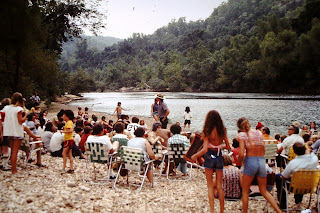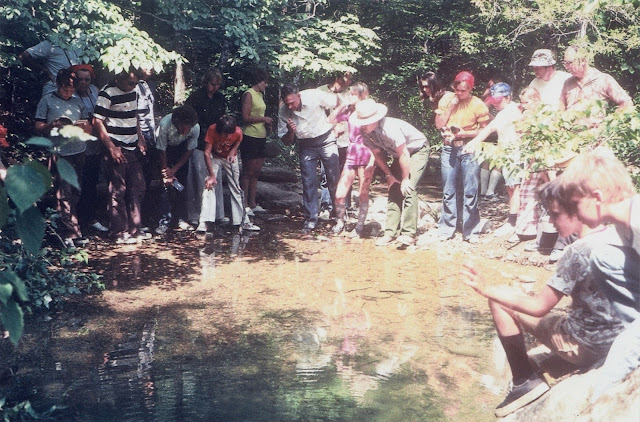Fifty years ago this summer I was working at Buffalo River as a naturalist for the National Park Service. It was a grand time and I loved it. In October you can help me celebrate those days and my birthday by joining me for a float down the Buffalo River.
It will be an interpretive trip like we use to do, seining fish, talking about the natural history of the river and the history of it’s people, and having a midday fish fry on a gravel bar somewhere. At the outset, I will teach folks how to paddle a canoe from one side. Fifty years ago, that’s what I and another naturalist did every day. I am doing this once again, and one last time, just like the old days.
I am worried about the Buffalo. Every year less water flows over it's shoals and as many as 600 canoes and kayaks now try to enjoy that great river in one day. It is becoming a mess, with jam-ups on shoals, and gravel bars littered with feminine products, toilet paper and worse, drug paraphernalia at times. The National Park Service can’t do anything about it, overwhelmed by the numbers.
Most problems nowadays don’t come from just the canoe rentals. At take-out points, there isn’t room for all the private vehicles, and sometimes you have to wait an hour or more to leave the river.
Most have no idea that the Buffalo is no longer the stream it once was, not close to what I saw fifty years ago. But they swarm to see it and experience it, and there are no controls. Private boats are not bound by Park Service rules, rules that limit what canoe rental companies have to do.
There are reasons why the water is receding in all Ozark rivers and there is nothing that can be done about it. It involves receding water tables in midwestern states, and there isn’t one person out of twenty that knows what you are talking about when you describe that problem.
Why? A population of humans that has more than doubled since I first saw the Buffalo, and a tremendous increasing number of deep wells serving industry, large scale irrigation, even 20 times more agricultural use. How many more cattle, hogs, chickens, turkeys, etc. are there today. Easily 20 times more, maybe 30 times more than there were 50 years ago. Forests that were sponges for rainfall have receded, to hardened pastureland. Cement and pavement have increased 100-fold from what they were fifty years ago.
When I was a naturalist on the Buffalo in 1971… when it was a state park before the Feds took it over… I would go around talking with local country folks who were the age I am today. There were a couple of those mountain ladies who did, in fact, smoke corn-cob pipes! I was there… I know. The biggest change in the Ozarks isn’t the water levels, it is the people. As different as night and day. Like I said, I know… I was there.
Those old Ozark people along the rivers, whether the Buffalo or the Big Piney or the Current would have hoped what you see there now would have never happened as it has. But I can tell you this, without the designation as a National River, the Buffalo would become another suburb for the wealthy, with mansions built on each bluff and real estate companies selling lots along the river just above the high water line.
I am going to be interviewing the Park Superintendent soon and will publish that interview. But can they do anything about what is happening? Not really. Millions flock to Yellowstone and Yosemite, but those are huge tracts of land and the millions are spread out at least to some extent. There, bad things are happening, and worse things are coming.
The Buffalo River is a ribbon-like park where thousands of visitors are concentrated in a narrow corridor and it is a bad scene, what is happening now. I don’t know what the NPS people are now, but I remember what they were fifty years ago.
But all that is for another column later. If you want to go on that last float with me, you need to contact me or Crockett canoe service. The date isn’t finalized yet, but will likely be the last Saturday of October. Usually there is a little more water then, and the bluffs are just like they were 50 years ago.
You can call me at 417 777 5227 or email me at lightninridge47@gmail.com
















